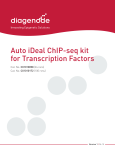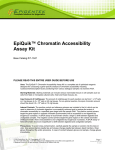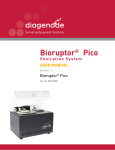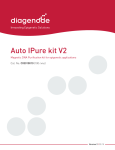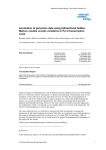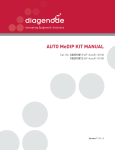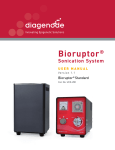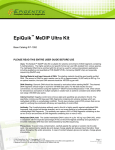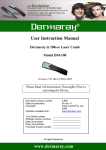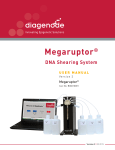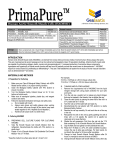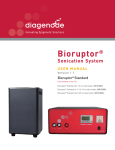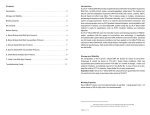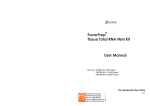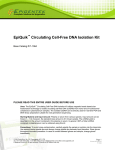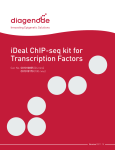Download - Diagenode
Transcript
Chromatin shearing optimization kit Low SDS (for Transcription Factors) Cat. No. C01020013 Version 1 I 06.15 Contacts DIAGENODE HEADQUARTERS Diagenode s.a. BELGIUM | EUROPE LIEGE SCIENCE PARK Rue Bois Saint-Jean, 3 4102 Seraing - Belgium Tel: +32 4 364 20 50 Fax: +32 4 364 20 51 [email protected] [email protected] Diagenode Inc. USA | NORTH AMERICA 400 Morris Avenue, Suite #101 Denville, NJ 07834 Tel: +1 862 209-4680 Fax: +1 862 209-4681 [email protected] [email protected] For a complete listing of Diagenode’s international distributors visit: http://www.diagenode.com/company/distributors.php For rest of the world, please contact Diagenode sa. Diagenode website: www.diagenode.com PAGE 3 Content Introduction. . . . . . . . . . . . . . . . . . . . . . . . . . . . . . . . . . . . . . . . . . . . . . . . . . . . . . . . . . . . . . . . . . . . . . . . . . . . . . . . . . . . . . . . . . . . . . . . . . . . . . . . . . . . . . . . . . . . . . . . . . . . . . . . . . . 4 Kit method overview and time table . . . . . . . . . . . . . . . . . . . . . . . . . . . . . . . . . . . . . . . . . . . . . . . . . . . . . . . . . . . . . . . . . . . . . . . . . . . . . . . . . . . . . . . . . . . . . . 4 Required materials not provided. . . . . . . . . . . . . . . . . . . . . . . . . . . . . . . . . . . . . . . . . . . . . . . . . . . . . . . . . . . . . . . . . . . . . . . . . . . . . . . . . . . . . . . . . . . . . . . . . . . 5 Remarks before starting . . . . . . . . . . . . . . . . . . . . . . . . . . . . . . . . . . . . . . . . . . . . . . . . . . . . . . . . . . . . . . . . . . . . . . . . . . . . . . . . . . . . . . . . . . . . . . . . . . . . . . . . . . . . . . . 5 Short protocol. . . . . . . . . . . . . . . . . . . . . . . . . . . . . . . . . . . . . . . . . . . . . . . . . . . . . . . . . . . . . . . . . . . . . . . . . . . . . . . . . . . . . . . . . . . . . . . . . . . . . . . . . . . . . . . . . . . . . . . . . . . . . . . . 6 Step 1. Cell collection and DNA-protein cross-linking . . . . . . . . . . . . . . . . . . . . . . . . . . . . . . . . . . . . . . . . . . . . . . . . . . . . . . . . . . . . . . . 6 Step 2. Cell lysis and chromatin shearing . . . . . . . . . . . . . . . . . . . . . . . . . . . . . . . . . . . . . . . . . . . . . . . . . . . . . . . . . . . . . . . . . . . . . . . . . . . . . . . . . 6 Step 3. Sheared chromatin analysis . . . . . . . . . . . . . . . . . . . . . . . . . . . . . . . . . . . . . . . . . . . . . . . . . . . . . . . . . . . . . . . . . . . . . . . . . . . . . . . . . . . . . . . . . . 7 Detailed protocol . . . . . . . . . . . . . . . . . . . . . . . . . . . . . . . . . . . . . . . . . . . . . . . . . . . . . . . . . . . . . . . . . . . . . . . . . . . . . . . . . . . . . . . . . . . . . . . . . . . . . . . . . . . . . . . . . . . . . . . . . . . 8 Step 1. Cell collection and DNA-protein cross-linking . . . . . . . . . . . . . . . . . . . . . . . . . . . . . . . . . . . . . . . . . . . . . . . . . . . . . . . . . . . . . . . 8 Step 2. Cell lysis and chromatin shearing . . . . . . . . . . . . . . . . . . . . . . . . . . . . . . . . . . . . . . . . . . . . . . . . . . . . . . . . . . . . . . . . . . . . . . . . . . . . . . . . . 8 Step 3. Sheared chromatin analysis . . . . . . . . . . . . . . . . . . . . . . . . . . . . . . . . . . . . . . . . . . . . . . . . . . . . . . . . . . . . . . . . . . . . . . . . . . . . . . . . . . . . . . . . . . 9 www.diagenode.com | PAGE 4 DIAGENODE CHROMATIN SHEARING OPTIMIZATION KIT - LOW SDS USER MANUAL Introduction The first critical step of a successful Chromatin Immunoprecipitation (ChIP) experiment is the preparation of sheared chromatin. We therefore suggest the use one of our optimized Shearing ChIP kits. • Chromatin Shearing Optimization kit - Low SDS (for Histones) (Cat. No.C01020010) • Chromatin Shearing Optimization kit – Low SDS (for Transcription Factors) (Cat. No. C01020013) • Chromatin Shearing Optimization kit - Medium SDS (Cat. No.C01020011) • Chromatin Shearing Optimization kit - High SDS (Cat. No.C01020012) Our Chromatin Shearing Optimization kits are used in combination with the Bioruptor in order to ensure a highly reproducible chromatin shearing and make sure you obtain the right fragment size needed for your experiment. Establish optimal conditions required for shearing cross-linked chromatin (protein-DNA) is usually laborious; the protocol of the Chromatin Shearing Optimization kits is fast, easy-to-use and optimized to get the best results possible. The ChIP assay offers great potential to improve knowledge about the regulation of gene expression. This technique is now used in a variety of life science disciplines including cellular differentiation, tumor suppressor gene silencing, and the effect of histone modifications on gene expression. Isolation and shearing of the chromatin after formaldehyde fixation is the first step in the ChIP method. The following two steps are: 1/ specific immunoprecipitation of chromatin fragments using antibody against the protein of interest and 2/ analysis of the immunoprecipitated DNA fragment. With the present kit, the first step of the ChIP method is guaranteed, providing you with the best results. Using standard protocols and kits leads to a significant decrease in potential variables that can occur from shearing to ChIP, which makes interpretation and analysis from experiment to experiment much more accessible. Figure 1: Representation of the chromatin Chromatin is that portion of the cell nucleus which contains all the DNA of the nucleus in animal or plant cells. DNA in chromatin is organised in arrays of nucleosomes. Two copies of histone proteins are assembled into an octamer that has 145-147 base pairs (bp) of DNA wrapped around it to form a nucleosome core. The nucleosome, in its role as the principal packaging element of DNA within the nucleus, is the primary determinant of DNA accessibility (Luger et al. 1997). Kit method overview and time table Step Time needed STEP 1 Cell Collection and DNA-protein crosslinking 1 to 2 hours STEP 2 Cell lysis and chromatin shearing 1 to 2 hours STEP 3 Sheared chromatin analysis 1 day Innovating Epigenetic Solutions PAGE 5 Required Materials Not Provided REAGENTS • Formaldehyde (37% stock) • Ice-cold PBS buffer • RNase cocktail (e.g. Ambion, AM 2286 A) • Phenol/chloroform/isoamyl alcohol (25:24:1) • Chloroform/isoamyl alcohol (24:1) • 100% Ethanol • 70% Ethanol • Agarose and TAE buffer • DNA molecular weight marker • Diagenode ChIP cross-link Gold (Cat N° C01019021) (Optional) EQUIPMENT • Cell scraper • Centrifuges (at 4°C) for 1.5 ml tubes and 15/50 ml tubes • Bioruptor from Diagenode • Agarose gel apparatus • 37°C/65°C incubator or water bath Remarks before starting Before starting the ChIP, the chromatin should be sheared to fragments in the 100 to 600 bp range. Our kits and protocols are optimized for Chromatin shearing using the Bioruptor® (Pico, Plus and Standard). The maximum volume for shearing with the Bioruptor® is 300 μl per 1.5 ml microtube (depending on the specific type). We recommend using TPX tubes (Cat. No.C30010010-1000) for Bioruptor Plus ans Standard and Bioruptor Microtubes with caps (C30010016) for Bioruptor Pico as shearing has been shown to be more efficient and reproducible using these tubes. The shearing conditions mentioned in the protocol are adequate for a variety of cell types. owever, given that cell types are different, we recommend optimizing sonication conditions for each cell type H before processing large quantities of cells or samples. Perform an initial sonication time course experiment to evaluate the extent of chromatin fragmentation. A protocol to assess the shearing efficiency can be found in the “additional protocols” section. The first step of the chromatin preparation is the cross-linking in order to fix protein-DNA interactions. Formaldehyde is the most commonly used cross-linking reagent. However, formaldehyde is usually not effective to cross-link proteins that are not directly bound to the DNA. For example, chromatin interactions with inducible transcription factors or with cofactors that interact with DNA through protein-protein interactions are not well preserve with formaldehyde. When studying this kind of factors, we recommend the use of the Diagenode ChIP cross-link Gold (Cat N° C01019021). This reagent is to use in combination with formaldehyde. The protocol involves a sequential fixation. A first protein-protein fixation by the ChIP cross-link Gold followed by protein-DNA fixation by formaldehyde. www.diagenode.com | PAGE 6 DIAGENODE CHROMATIN SHEARING OPTIMIZATION KIT - LOW SDS USER MANUAL Short protocol for experienced users STEP 1. Cell collection and DNA-protein cross-linking Note: When studying inducible transcription factors or co-factors, it is recommended to perform the fixation using the ChIP cross-link Gold (C01019021) in addition to the formaldehyde fixation 1. Dilute formaldehyde in Fixation buffer to a final concentration of 11%. 2. Add 1/10 volume of diluted formaldehyde directly to the cell culture medium. 3. Incubate at room temperature for 10 to 20 minutes with gentle shaking. 4. Stop the fixation by adding 1/10 volume of glycine. STEP 2. Cell lysis and chromatin shearing For adherent cells (~25 million cells): 5a. Remove the medium and wash the cells once with 20 ml of PBS. Keep everything at 4°C from now on. 6a. Add 5 ml of cold lysis buffer iL1b to the plate and collect the cells by scraping. 7a. Rinse the flask with an additional 20 ml of buffer iL1b. 8a. Incubate at 4°C for 20 minutes. For suspension cells (~25 million cells): 5b. Collect the cells by centrifugation at 1,600 rpm and 4°C for 5 minutes. 6b. Wash the cells once with 20 ml of PBS. Keep everything at 4°C from now on. 7b. Resuspend the cells in 25 ml of cold lysis buffer iL1b. 8b. Incubate at 4°C for 20 minutes. 9. Discard the supernatant and resuspend the cells in 15 ml lysis buffer iL2. Incubate at 4°C for 10 minutes with gentle mixing. 10. Centrifuge at 1,600 rpm and 4°C for 5 minutes. 11. Add 1/200 volume protease inhibitor cocktail (PIC) to shearing buffer iS1b. 12. D iscard the supernatant and resuspend the cells in shearing buffer iS1b + PIC to a final concentration of 15 million cells/ml. Resuspend by pipetting up and down. 13. Shear chromatin by sonication using the Bioruptor®. An initial time course experiment is recommended. • For Bioruptor® Standard or Plus use High power setting for 10-30 cycles (30 seconds ON, 30 seconds OFF). Stop the system after each run of 10 cycles, vortex and spin down sample. • For Bioruptor® Pico, sonicate samples for 5-15cycles (30 seconds ON, 30 seconds OFF). Vortexing is not required between runs. 14. C entrifuge at 13,000 rpm (16,000 x g) for 10 minutes and collect the supernatant which contains the sheared chromatin. STEP 3. Sheared chromatin analysis 15. Spin 50 µl of the sheared chromatin at 12,000 rpm for 10 min at 4°C. Use the supernatant for chromatin analysis. 16. Add 2 μl of diluted RNase cocktail and incubate 1h at 37°C. Innovating Epigenetic Solutions PAGE 7 17. Add 50 μl of elution buffer iE1 and 4 μl of elution buffer iE2, mix thoroughly. 18. Incubate samples at 65°C for 4h (or overnight). 19. E xtract DNA once with an equal volume of phenol/chloroform/isoamyl alcohol (25:24:1). Incubate the sample at RT for 10 min on a rotating wheel. 20. Centrifuge for 2 min at 13,000 rpm at RT. Transfer the top aqueous phase into a new 1.5 ml tube. 21. Add 1 volume of chloroform/isoamyl alcohol (24:1). Incubate the sample at RT for 10 min on a rotating wheel. 22. Centrifuge for 2 min at 13,000 rpm at RT. Transfer the top aqueous phase into a new 1.5 ml tube. 23. Precipitate the DNA by adding 10 μl DNA precipitant, 5 μl of co-precipitant, and 500 μl of cold 100% ethanol to the sample. Incubate at -80 °C for 30 min. 24. Centrifuge for 25 min at 13,000rpm at 4°C. Add 500 μl of ice-cold 70% ethanol to the pellet. 25. Centrifuge for 10 min at 13,000 rpm at 4°C. Air-dry the pellet. 26. Re-suspended the pellet in 20 μl of TE buffer. 27. Run samples in a 1.5% agarose gel. www.diagenode.com | PAGE 8 DIAGENODE CHROMATIN SHEARING OPTIMIZATION KIT - LOW SDS USER MANUAL Detailed protocol STEP 1. Cell collection and DNA-protein cross-linking Note: When studying inducible transcription factors or cofactors, it is recommended to perform the fixation using the ChIP cross-link Gold (C01019021) in addition to the formaldehyde fixation 1. D ilute formaldehyde in Fixation buffer to a final concentration of 11%, e.g. add 5 ml of a 37% formaldehyde solution to 11.8 ml Fixation buffer. For a T175 culture flask you will need ~2 ml of diluted formaldehyde. 2. Add 1/10 volume of the diluted formaldehyde directly to the cell culture medium. 3. Incubate the cells for 10 to 20 minutes at room temperature with gentle shaking. The fixation time can depend on your target of interest. 4. A dd 1/10 volume of Glycine to the cell culture medium to stop the fixation. Incubate for 5 minutes at room temperature with gentle shaking Note: The fixed cells can be stored at -80°C for up to 4 months. However, we strongly recommend using freshly fixed cells for preparation of sheared chromatin prior to ChIP for ChIP-sequencing. STEP 2. Cell lysis and chromatin shearing For adherent cells: 5a. Remove the medium and wash the cells once with 20 ml of PBS. Keep everything at 4°C from now on. 6a. Add 5 ml of cold Lysis buffer iL1b to the plate and collect the cells by scraping. 7a. A dd an additional volume of Lysis buffer iL1b to rinse the flask and add this to the collected cells. The total volume of Lysis buffer iL1b should be about 10 ml per 107 cells (e.g. for a T175 culture flask (~25 milllion cells), rinse with an additional 20 ml of buffer iL1b. 8a. Incubate at 4°C for 20 minutes. For suspension cells: 5b. Pellet the cells by centrifugation at 1,600 rpm and 4°C for 5 minutes. Discard the cell culture medium. 6b. Wash the cells once with PBS. Resuspend the cells in 20 ml of PBS, centrifuge at 1,600 rpm and 4°C for 5 minutes and discard the supernatant. Keep everything at 4°C from now on. 7b. Add 1 ml ice-cold lysis buffer iL1b to the cell pellet and resuspend the cells by pipetting up and down several times. Add an additional amount of buffer iL1b to obtain a total volume of about 10 ml per 107 cells (e.g. for a T175 culture flask (~25 milllion cells), add an additional 24 ml of buffer iL1b. 8b. Incubate at 4°C for 20 minutes. 9. Pellet the cells by centrifugation at 1,600 rpm for 5 minutes and 4°C and discard the supernatant. 10. Add 1 ml ice-cold Lysis buffer iL2 to the cell pellet and resuspend the cells by pipetting up and down several times. Add an additional amount of buffer iL2 and incubate for 10 minutes at 4°C with gentle mixing. For 25 million cells the total amount of iL2 should be 15 ml. 11. Pellet the cells again by centrifugation for 5 minutes at 1,600 rpm (500 x g) and 4°C and discard supernatant. 12. Add 200x protease inhibitor cocktail to Shearing buffer iS1b. Prepare 1 ml of complete shearing buffer per tube of 15 million cells. Keep on ice 13. Add 1 ml of complete Shearing buffer iS1b to 15 Million cells. Resuspend the cells by pipetting up and down several times. The final cell concentration should be 1.5 Million cells per 100 μl buffer iS1b. Split into aliquots of 100 to 300 μl and transfer the cell suspension to 1.5 ml TPX microtubes (Cat. No.C30010010-1000 ) when using the Bioruptor Innovating Epigenetic Solutions PAGE 9 Standard or Plus or to 1.5 ml Bioruptor® Microtubes with Caps (Cat No C30010016) optimized for chromatin shearing with the Bioruptor® Pico. 14. Shear the chromatin by sonication using the Bioruptor®. When using the Bioruptor Standard or Plus, shear for 1 to 3 runs of 10 cycles [30 seconds “ON”, 30 seconds “OFF”] each at high power setting. Briefly vortex and spin between each run. Shear for 8-10 cycles [30 seconds “ON”, 30 seconds “OFF”] when using the Bioruptor Pico. These shearing conditions will work excellent for many cell types. However, depending on the cell type and Bioruptor® system used, optimisation may be required. 15. Centrifuge at 13,000 rpm (16,000 x g) for 10 minutes and collect the supernatant which contains the sheared chromatin. Use the chromatin immediately in immunoprecipitation or store it at -80°C for up to 2 months. If desired, the chromatin shearing effciciency can be analysed at this step (see the protocol in Additional protocols.) STEP 3. Sheared chromatin analysis 16. Take an aliquot of 50 μl of sheared chromatin and spin the chromatin at 12,000 rpm for 10 min at 4°C. Transfer the supernatant to a new tube for chromatin analysis. 17. Prepare RNase cocktail dilution (e.g. Ambion, AM 2286 A: dilute 1μl of cocktail in 150 μl of ChIP-seq grade water). 18. Add 2 μl of diluted RNase cocktail. 19. Incubate 1h at 37°C. 20. Add 50 μl of elution buffer iE1. 21. Add 4 μl of elution buffer iE2, mix thoroughly. 22. Incubate samples at 65°C for 4h (or overnight). 23. Extract DNA once with an equal volume of phenol/chloroform/isoamyl alcohol (25:24:1). Incubate the sample at RT for 10 min on a rotating wheel. 24. Centrifuge for 2 min at 13,000 rpm at RT. Transfer the top aqueous phase into a new 1.5 ml tube. 25. Add 1 volume of chloroform/isoamyl alcohol (24:1). Incubate the sample at RT for 10 min on a rotating wheel. 26. Centrifuge for 2 min at 13,000 rpm at RT. Transfer the top aqueous phase into a new 1.5 ml tube. 27. Precipitate the DNA by adding 10 μl DNA precipitant, 5 μl of co-precipitant, and 500 μl of cold 100% ethanol to the sample. Incubate at -80 °C for 30 min. 28. Centrifuge for 25 min at 13,000rpm at 4°C. Carefully remove the supernatant and add 500 μl of ice-cold 70% ethanol to the pellet. 29. Centrifuge for 10 min at 13,000 rpm at 4°C. Carefully remove the supernatant, leave tubes open for 30 min at RT to evaporate the remaining ethanol. 30. Re-suspended the pellet in 20 μl of TE buffer. 31. Run samples (20 μl of DNA + 4 μl of 6x loading dye) in a 1.5% agarose gel. www.diagenode.com | PAGE 10 DIAGENODE CHROMATIN SHEARING OPTIMIZATION KIT - LOW SDS USER MANUAL Figure 2: Successful Chromatin shearing of chromatin from «difficult cells» (K562) K562 cells (myelogenous leukemia cell line) are fixed with 1% formaldehyde (for 15 min at RT). Nuclei isolation of 4,5 millions fresh cells are performed using buffers of Diagenode’s Chromatin Shearing Optimization kit - Low SDS (for iDeal ChIP-seq kit for TFs) and are then resuspended in 300 μl of Shearing Buffer iS1b prior to Chromatin shearing. Samples are sheared during 1 or 2 rounds of 5 cycles of 30 sec ON/ 30 sec OFF with the Bioruptor Pico combined with the Bioruptor Water cooler (Cat. No. B02010002) & Single Cycle Valve (Cat. No. B0202004). All samples were treated with RNase and reverse cross-linked. 10 μl of DNA (equivalent to 300 ng) are analyzed on a 1.5% agarose gel. This example clearly shows that "difficult cells" such as K562 can readily be sheared using the Bioruptor®. Innovating Epigenetic Solutions FOR RESEARCH USE ONLY. Not intended for any animal or human therapeutic or diagnostic use. © 2015 Diagenode SA. All rights reserved. No part of this publication may be reproduced, transmitted, transcribed, stored in retrieval systems, or translated into any language or computer language, in any form or by any means: electronic, mechanical, magnetic, optical, chemical, manual, or otherwise, without prior written permission from Diagenode SA (hereinafter, "Diagenode”) . The information in this guide is subject to change without notice. Diagenode and/or its affiliates reserve the right to change products and services at any time to incorporate the latest technological developments. Although this guide has been prepared with every precaution to ensure accuracy, Diagenode and/or its affiliates assume no liability for any errors or omissions, nor for any damages resulting from the application or use of this information. Diagenode welcomes customer input on corrections and suggestions for improvement. NOTICE TO PURCHASER LIMITED LICENSE The information provided herein is owned by Diagenode and/or its affiliates. Subject to the terms and conditions that govern your use of such products and information, Diagenode and/or its affiliates grant you a nonexclusive, nontransferable, nonsublicensable license to use such products and information only in accordance with the manuals and written instructions provided by Diagenode and/or its affiliates. You understand and agree that except as expressly set forth in the terms and conditions governing your use of such products, that no right or license to any patent or other intellectual property owned or licensable by Diagenode and/or its affiliates is conveyed or implied by providing these products. In particular, no right or license is conveyed or implied to use these products in combination with any product not provided or licensed to you by Diagenode and/or its affiliates for such use. Limited Use Label License: Research Use Only The purchase of this product conveys to the purchaser the limited, nontransferable right to use the product only to perform internal research for the sole benefit of the purchaser. No right to resell this product or any of its components is conveyed expressly, by implication, or by estoppel. This product is for internal research purposes only and is not for use in commercial applications of any kind, including, without limitation, quality control and commercial services such as reporting the results of purchaser's activities for a fee or other form of consideration. For information on obtaining additional rights, please contact [email protected]. TRADEMARKS The trademarks mentioned herein are the property of Diagenode or their respective owners. Bioruptor is a registered trademark of Diagenode SA. Bioanalyzer is a trademark of Agilent Technologies, Inc. Agencourt and AMPure are registered trademarks of Beckman Coulter, Inc. Microcon is a registered trademark of Millipore Inc. Illumina is a registered trademark of Illumina Inc. Ion Torrent and Personal Genome Machine are trademarks of Life Technologies Corporation. Qubit is a registered trademark of Life Technologies Corporation.












